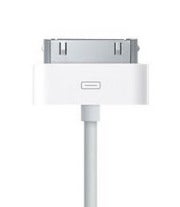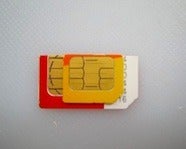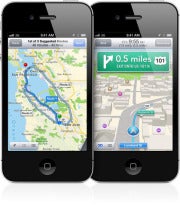
The latest beta releases of iOS 6 are now giving a clearer indication of which of Google’s services Apple will drop or replace with its own, with several reports indicating upcoming design and hardware changes that you’ll have to keep in mind. Until the new iPhone is announced on September 12, as reports indicate, here are the changes being discussed and what they mean.
Bye Bye Google Maps
New Apple iOS 6 mapsApple bought several mapping companies to produce its own mapping product – replacing the Google Maps-powered Maps app. The main difference between Apple’s and Google’s maps products is that the first uses resolution independent vector maps, while the latter uses layered images for each zoom level. The advantage to Apple’s solution is that you don’t have to wait for blocks to load as you zoom in, because maps are being rendered live on the phone, which gives you a smoother experience.Like Google Maps for Android, Apple is introducing in its iOS 6 Maps app 3D buildings and turn-by-turn (voice) navigation, but there will be one main thing missing: Google's Street View, which Apple’s app doesn’t feature. Google already has the Earth app for iOS, so it’s entirely possible the company would release a standalone Google Maps app in the App Store, just like it said it would with another soon-to-be-gone iOS app: YouTube
Sayonara YouTube
The lack of a YouTube app probably won’t make a big difference to users. You will be able to watch YouTube clips straight from Safari on the mobile version of the site, instead of having a link open automatically in the YouTube app automatically.
In developing its own YouTube app, Google will also have the ability to introduce advertisements in the app (something not present in the current app), and also update the app with new features more often. In Apple’s hands, the YouTube app has seen very little improvements over the years.
Adieu 30-Pin Dock Connector

However, moving to a new and smaller dock connector won’t be without its problems. While accessory manufacturers slowly start adopting the new plug as new iPhone sales grow, Apple is expected to introduce an adaptor that would make the new iPhone (and later iPads) compatible with the old-style adaptors. However, the new dock connector should also make people less reliant on using wired accessories and push sales of AirPlay-compatible accessories.
Arrivederci microSIM

While the smaller SIM card might make a difference for Apple’s internal iPhone design, for users the transition should be quite straightforward. The nanoSIM can be packaged and distributed in a way that is backwards compatible with existing SIM card designs.
Ref:
Pcworld

No comments:
Post a Comment